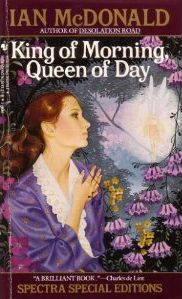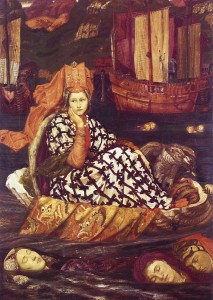 I’ve been looking forward to rereading Ian McDonald’s King of Morning, Queen of Day (Bantam, 1991) as it was one of the inspirations for my Askmore story cycle, and I particularly wanted to see how the novel held up for me as a reader (I’ve not read it since 1991, when it was first published). One of the main aspects of the novel that intrigued me originally—and part of which inspired my Askmore story cycle—was the generational structure. The novel is divided into four Parts, each focused on a female character and using a different style/structure. Warning: Spoilers to follow.
I’ve been looking forward to rereading Ian McDonald’s King of Morning, Queen of Day (Bantam, 1991) as it was one of the inspirations for my Askmore story cycle, and I particularly wanted to see how the novel held up for me as a reader (I’ve not read it since 1991, when it was first published). One of the main aspects of the novel that intrigued me originally—and part of which inspired my Askmore story cycle—was the generational structure. The novel is divided into four Parts, each focused on a female character and using a different style/structure. Warning: Spoilers to follow.
In the first Part, “Craigdarragh,” the main character, Emily Desmond, daughter of an astronomer and a poet, lives in 1913 Ireland. Here McDonald uses a multitude of voices in the forms of diary or notebook entries from various characters, newspaper reports, police reports, lectures, letters, and sound archives. On the one hand, the “collected document” format gives the section a sense of “historical” quality in terms of its gathering of said documents, which helps root the story in a real world setting and asks the reader to question the “fantastical” events that happen. The fantasy is readily apparent only through fifteen-year-old Emily’s diary entries, which describe her longing for the Otherworld initially and then record her sightings of and interactions with various faery. Thus the reader doesn’t engage with the fantastic directly but only through the lens of Emily’s diary, and so might speculate that what Emily believes happens hasn’t actually happened. McDonald effectively controls the flow of information to the reader so that when Emily disappears at the end of the first Part, the mystery is heightened because the reader has only these documents to use in piecing together facts rather than relying on a more forthcoming narrator to clarify.
When I first read the novel, I thought McDonald moved from fantasy to science fiction over the course of the narrative, but in reading it again I think the novel is actually science fiction from beginning to end. Even though Emily sees the faery and believes them to be magic, she produces her own theory of the Otherworld that works in scientific terms rather than fantastic:
I am developing a theory about the faery: it is that our world and Otherworld lie one inside the other, like the concentric spheres of the carved Dutch globes, along different places of being… there may be times when our world’s axis is inclined at a different angle from that of Otherworld, with the result that the surface of Otherworld touches, then passes through, the surface of the world. (38-39)
As it turns out, Emily’s theory is incorrect—the faery are actually creations of the Mygmus or mythoconsciousness that Emily and her descendants can shape to their will, not a separate world but something that arises from the real world—but the fact that she posits a scientific hypothesis to explain the faery is relevant to the un-fantastic nature of the novel.
In the second Part, “The Mythlines,” McDonald again uses multiple points of view, but in a more controlled manner than in the first section (other than chronology, the documents in the first section are arranged as they are for no particular reason). “The Mythlines” alternates between three narratives, which eventually merge in the end; these sections are simply numbered, unlike the complex section heading from “Craigdarragh,” such as “From the Private Notebooks of Constance Booth-Kennedy: March 23, 1913” (11). The first narrative follows Tiresias/Watchman and Gonzaga/Dreamspinner; the second follows Jessica Caldwell, abandoned daughter of Emily Desmond and later adopted daughter of the Caldwells (after her first set of adoptive parents were killed in fire, during which the infant Jessica “creates” Watchman and Dreamspinner from the Mygmus to protect her); and the third follows Dr. Hannibal Rooke, a psychologist/hypnotherapist whom we first meet when he’s called in to find a cure for Emily Desmond’s odd behavior. The Tiresias & Gonzaga and Jessica sections are in third person, but Rooke’s sections are in first person, which I thought was an interesting choice (and something Charles de Lint does with some regularity) as the alternation lends itself to more increased knowledge of the narrative compared with the first Part. The third-person narrator gives the reader an over-the-shoulder perspective—we know some but not all, and discover the truth as Jessica does—and the first-person narrator gives us a more intimate account (and can range back to Emily without that information feeling forced on the narrative). McDonald maintains an exact ordering of those three narratives until near the end, when two sections of Jessica’s narrative (14 and 15) follow back-to-back inexplicably and then Rooke’s sections incorporate Tiresias & Gonzaga, and in the last section Rooke and Watchman & Dreamspinner are merged into Jessica’s narrative.
“Coda: Late Summer,” the third Part, is only four pages long, far under the lengths of the other three Parts. I think the writing in “Coda: Late Summer” is the most beautiful in the book—and the entire four pages is one, long sentence. It has echoes, to American readers, of William Faulkner, of course, but I imagine McDonald was inspired more by James Joyce in writing it, especially by Molly Bloom’s soliloquy in Ulysses, as the Coda is about Jessica’s first sexual experience with her future husband:
…like lovers from old old legends, and under the hot sun with the bees swimming lazily about them, heavy with nectar, she opened to him and he entered her and pushed pushed pushed and she went oh oh oh afraid that she was going to die afraid that she was not going to die from something wonderful and terrible at the same time, like God, she thought on the heather and bracken bed… (229-230)
Why would McDonald choose to change his style—and sentence length—so dramatically for the Coda? Reading the sustained sentence creates a definite feeling for the reader, a sense of headiness and poetry akin to young love, full of the same intensity and breathlessness. Jessica’s relationship with her husband, although we see them together only in this Part, seems to be the most grounded and most authentic in the novel. Perhaps McDonald wanted to pay homage to that kind of true love.
Less about the problem of love than facing the business at hand, “Shekinah,” the third Part, is set in a PDA-savvy early 1990s, the same time as the novel is published. Here McDonald uses the present tense to create a sense of immediacy, and he includes a lot of previous events in past tense, but to be honest I often found myself confused as he shifted from present to past and back again. I understood a lot of the past events described to be happening all in the present, which meant some rereading on my part. He also shifts into second-person for a paragraph on page 288 which I wasn’t quite sure I understood. Those quibbles aside, the narrative and the writing here feel tighter overall; it’s as if the novel increases its cohesiveness as it goes. Enye MacColl is the main character here, the granddaughter of Jessica Caldwell, and her narrative’s told entirely in third-person; her section is also the longest at 156 pages (Emily’s comes in at 104 pages and Jessica’s at 113). McDonald manages to reconcile the earlier sections—Emily has been consumed by the Mygmus and turned into the Adversary, first trying to destroy her daughter Jessica (perhaps because Jessica herself had power over the mythoconscious and was thus a threat) and then trying to destroy Enye in this last Part. What’s interesting is that Jessica doesn’t pass along any information about her mother (the Adversary) or the Mygmus to either her son or her granddaughter. Enye instead receives direction from Rooke, who at his death has instructed documents be sent to Enye that begin her on the journey towards a final confrontation with the Adversary.
The end of the novel gave me pause, as I wonder why McDonald relies on one of the three traditional feminine endings for a novel (marriage, childbirth, death, or a combination thereof) instead of trying something more experimental to match the rest of the novel. Granted, I like the symmetry and cyclical quality of Enye’s unborn daughter being suffused with the essence of Emily pulled out of the Mygmus at the final confrontation, but, for such a nontraditional character as Enye, falling back on such a traditional ending felt vaguely disappointing.
I enjoyed reading King of Morning, Queen of Day as much this time around as I did the first, especially as I paid closer attention to how McDonald went about constructing his narrative and how he built his structure (and the effectiveness of different styles within one novel). Highly recommended as a good read and a good object of study for writers.





